Making Shoo-Fly Pie
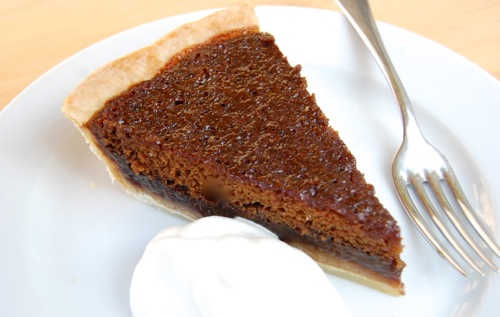
You know that huge stash of syrups and sugars I had after the sweetener extravaganza? It’s gone now. That’s what a couple treacle tarts and four or five shoo-fly pies will do. At least I won’t be worrying about ants.
Why so much trouble with shoo-fly pie? Because of the crust. As a rule I don’t like pie crusts that aren’t pre-baked. They can have a cereal mouthfeel that results from uncooked flour. They also get wet and sloppy, especially when a pie filling goes in as runny as this one does. True, for some people “wet bottom” shoofly pie is a delicacy. For those folks an unbaked crust is the way to go.
Me I like my crusts firm and flaky. The trouble has been that every time I pre-baked the crust I got a couple cracks or holes. No big deal with most fillings, but in this case the filling just ran right through, causing a sticky, unsightly mess. Reader Heather helped me solve the problem by suggesting some egg wash. This turned out to be the key to Joe’s perfect shoo-fly pie. Thanks to everyone who wrote in with suggestions!
Begin by assembling your ingredients and preparing a pie crust. Roll it out and rest it in the refrigerator for at least an hour. Meanwhile, preheat your oven to 425 degrees Fahrenheit. Poke a few holes in the crust with a skewer to prevent bubbling up (I know, I said cracks and holes are death with this pie, but don’t worry, we’ll plug them back up when they’ve served their purpose).
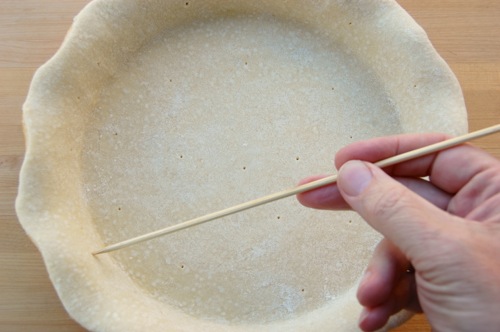
Lay in some parchment paper or foil.

Now add some weights. You can use beans, rice or clay weights. Those who know me know I like loose change. Spread it around well.
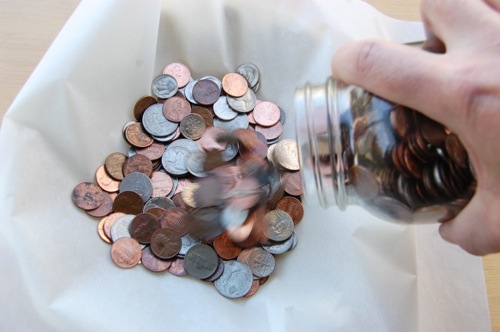
Bake the crust for 10 minutes, remove the paper and weights, then bake another five until it’s barely browned at the edges. As soon as you remove it from the oven, paint on some egg wash. Plain egg white is probably best since it will cook up on contact, but beaten egg will also work. Now allow that to cool while you work on the filling. Turn the oven down to 375.

Combine the butter, salt, sugar and flour in a large bowl.
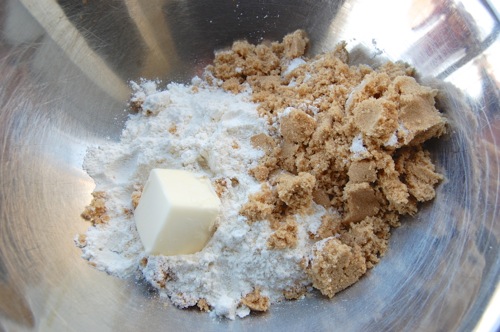
Rub it all together into “crumbs”. A lean streusel is what this is.
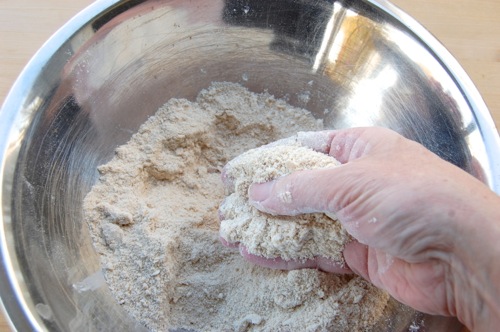
Pour half into the pie shell and reserve the rest.
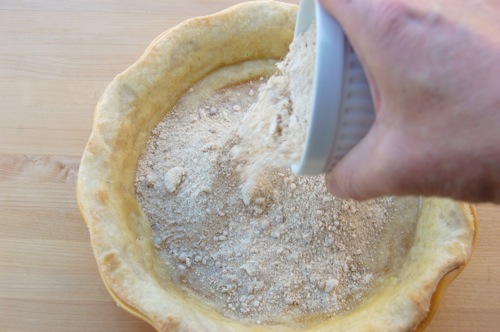
In another large bowl spoon in the baking soda.
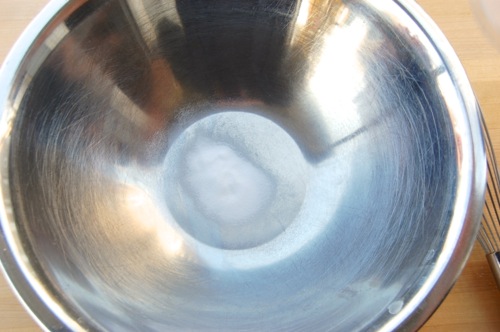
Add the hot water…you’ll see the reaction starting.
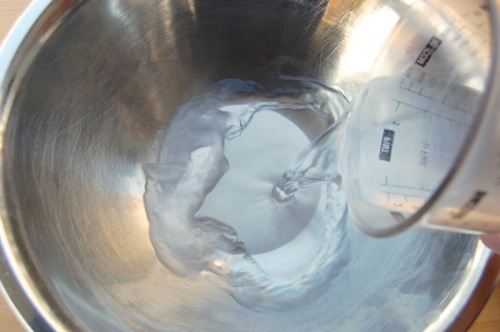
Promptly add the molasses. See the bubbles there?
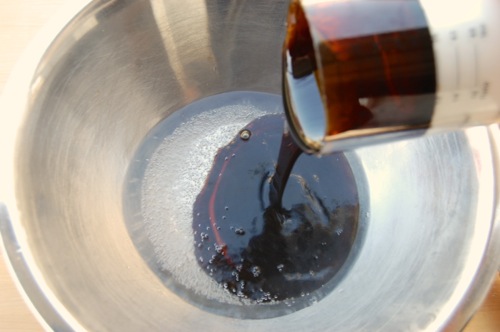
Now the egg…
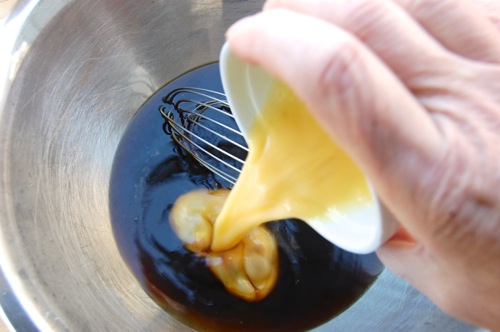
…and the rest of the crumbs.
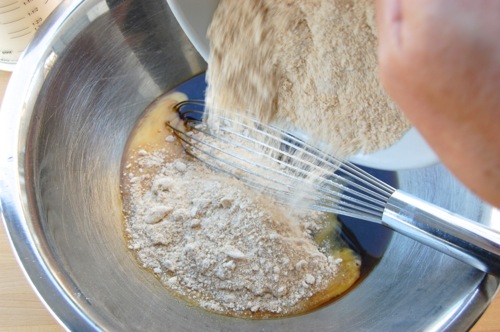
Whisk it all together…
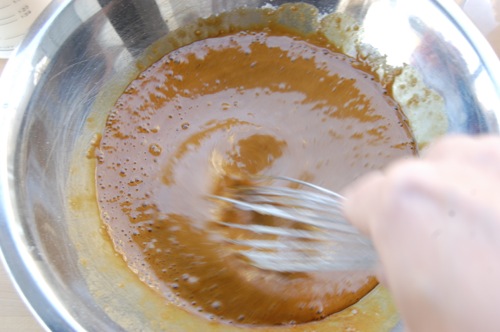
…and pour it into the cooled crust.
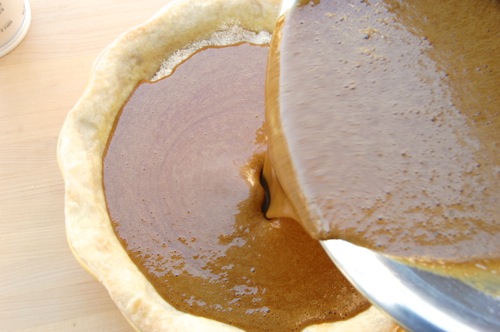
Bake it at 375 for ten minutes, then turn down the heat and bake for about 30 minutes at 300 until the pie no longer sloshes in the center when you move it. Place it on a rack to cool for about two hours, then chill it for another hour or so in the refrigerator.
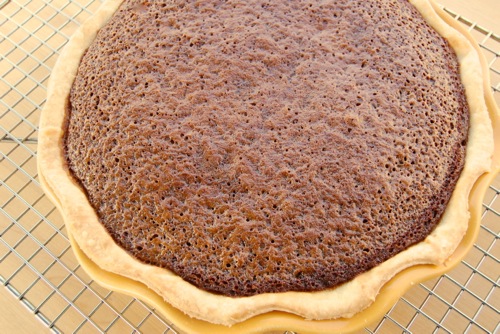
Slice and serve it with whipped cream, which is pretty much essential for a pie this sweet. I should add that shoo-fly pie has a strong molasses taste. If you don’t like that you can cut the molasses with light corn syrup, or even replace it completely with dark corn syrup which will give you the color without the molasses taste. Golden syrup is another possibility. Have fun!

Hi Joe.
This pie looks divine! In the picture, it looks like there are two distinct layers the more syrupy bottom and the more cakey top. So I was wondering why do you put half the streusel on the bottom and mix the rest in with the liquids when you end up pouring it all over the dry streusel any way? What does that technique accomplish? Thanks!
Eva
Hi Eva! Yes, that’s true. The gas bubbles in the mixture rise, creating an airier top layer and a thicker, more syrupy bottom. Another egg would probably even that out if it’s a concern, but I personally like it (a variety of texture donchaknow). This is a phenomenal pie, especially as I said with a little (or a lot of) whipped cream on the side.
The strategy of separating the crumbs is so they don’t all end up on top. Even though most of them will rise, at least a little of the flour will remain down below where it will gelatinize and thicken the liquid. It’s essential for preventing a runny lower layer and wet crust.
Enjoy your weekend!
– Joe
Lovely! I just made a molasses cake, which was excellent, but I’m ready for more. This sounds like it will fit the bill perfectly.
If you like molasses you’ll love this! Let me know how it goes, Lily!
– Joe
Hi! It’s the first time visiting your blog and it’s amazing!!where can I find the quantinty for the ingredients?It’s just me or there aren’t any?
thank you and congrats again!
Hey Erika! I get that question a lot because of the way I organize it. If you go to the recipes in the menus on the left you’ll find the recipes at the bottom, under the tutorials. I should probably change that system on of these days!
– Joe
That looks more what I imagine a treacle tart looks like. I’m with you on the soggy bottom or soggy any part of pastry. Should be flaky and firm. That’s one good lucky pie. Glad you solved the dilemma.
Thanks LInda! A treacle tart can be dark if you use a brown treacle (what we call molasses). The refiner’s syrup version is a treat however…very sweet!
Cheers,
– Joe
Joe,
On the topic of these sugar/syrup based pies: How are shoo-fly and treacle tart different from chess pie? I’ve never made one (although I’ve made and loved sugar cream and “KY horse race” pies), but have heard a lot about them and they sound of the same family.
Hey Ron!
Good question. Chess pie is another sugar pie, but it’s more custard-like, so a lot heavier in eggs. Generally no brown sugars either. The chess pies I’ve had a very light in color.
Hope that helps!
– Joe
I’m totally with you on unbaked pie/tart crusts…
Yeah, it’s an extra step and a bit of a pain, but really, sloppy pie crusts really don’t appeal to me at all.
Thanks for the support, Henry! 😉
– Joe